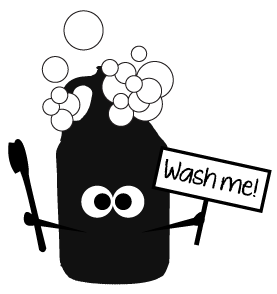
 Caring for your precious growler — after all, without it there wouldn't be that delicious reward of drinking your fresh craft beverage at home! In order to ensure your beverage experience is what it should be, you are responsible for maintaining the cleanliness of your growler while we are responsible for a proper fill of your choice beverage. If you had beer spilled all over you (a travesty!) you would take a shower too right? We'll let it slide if you would try to save as much beer as possible first by licking your arms (we would too!).
Caring for your precious growler — after all, without it there wouldn't be that delicious reward of drinking your fresh craft beverage at home! In order to ensure your beverage experience is what it should be, you are responsible for maintaining the cleanliness of your growler while we are responsible for a proper fill of your choice beverage. If you had beer spilled all over you (a travesty!) you would take a shower too right? We'll let it slide if you would try to save as much beer as possible first by licking your arms (we would too!).
Proper cleaning is critical to extending the life of your growler and maintaining quality beverages. The Brewers Associate recently released an informational fact sheet about growlers that you can download here. We have included the highlights below:
 | | Keep your growler cold until all of your delicious beverage has been consumed (for the beverage's sake we hope you are doing this already). |
 | | Once the growler is empty, ensure the detergents you intend to use are not fat or oil-based. Rinse the growler with piping hot water. Three times should do the trick, and get anything that shouldn't be in there, out! |
 | | Air dry your growler upside down and leave the lid off until you decide to return for a new fill! |
 | | Follow these same steps for your growler cap, which like all things are meant to be used multiple times but have their lifecycle. When good things come to an end and your growler cap isn't performing to standard, we will provide you with a new cap to ensure proper sealing of your growler. |
Craft beer quality is of the utmost importance to us. We want to maintain the exact beer the brewer indended. This is why our lines and taps are cleaned regularly and also why we ask for clean growlers from the consumers. For us to ensure we are filling a sanitary container we will "inspect" your growler (by taking a smell & peek). If you haven't been living up to growler standards and we aren't facing a growler rush hour, we wil help sanitize your growler while reminding you of these critical maintenance steps. But if you become a gross growler repeater, or your growler smells like something out of a college locker room, we will ask you to purchase a clean growler to fill with a delicious beverage. After all, we don't want to compromise all the work the brewers put into the beverage you are about to enjoy!
Tin pails, pitchers, glass jars or jugs, and other vessels are used to carry beer home from the local pub, most common being a 2-quart galvanized or enameled pail. These "growlers" supposedly got their name because as the beer sloshed around, it caused the carbon dioxide to escape and create a growling noise.
Prior to WWII, children would bring covered buckets of beer from the local pub to workers at lunch time, or to their parents at dinner time. This became known as "rushing the growler". The "Bucket Trade" was in action during the years leading up to Prohibition, until growlers were outlawed entirely.
The tin pail had been phased out and waxed cardboard containers with lids were being used. By the 1960s, however, most bars had switched to plastic containers and were now allowed to sell pre-packaged beer after hours, so the concept of the growler slowly disappeared.
Charlie Otto, owner of Wyoming's first draft-only microbrewery, wanted to offer beer to go, but couldn't bottle it. Luckily, his father remembered the use of growlers and suggested they try them. So he printed his logo on half-gallon glass jugs and the growler as we know it today was born!
We love to hear from our customers and fans - leave us a message below and we will get back to you shortly!